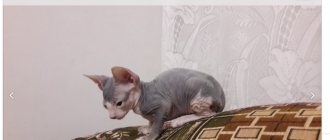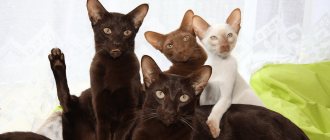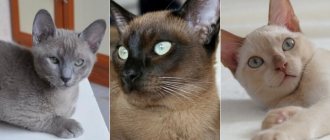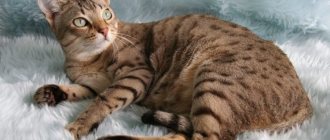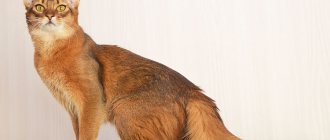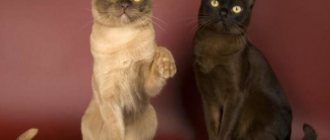Determination of color
Color point is a derivative of a combination of two English words: color (color) and point (point). Its visual expression is characterized by the contrasting difference between the light body of the animal and the accentuated ends of the limbs.
The most typical representative of this class is the Siamese breed, from which, apparently, the entire selection line came.
The distinctive features of the color point color appear as follows:
- light monochromatic hair on the body;
- clearly visible darkening on the legs, tail and ears;
- a contrast mask on the muzzle that can spread over its entire surface or be located only in the nose area.
The color of the limbs and its saturation depend on additional reasons.
Interesting: All colorpoint kittens are born without signs of future pigmented areas, but they appear already in the first week of life.
Difficulties in breeding tabby cats
When breeding tabby cats, difficulties arise if you do not know what dominant and recessive genes are and how they are passed on to future offspring. By their nature, all cats are initially tabbies, since the T (tabby) gene is present in their genetic code, although the pattern does not always appear.
Color genetics:
- The color of the skin and the appearance of ornaments on it are influenced by the agouti gene (A). It has the ability to color hairs in different shades. The shade lies in transverse lines alternating from light to dark.
- If the agouti gene is dominant (AA), the dark stripes on the hairs are colored more densely, and the light areas receive less coloring pigment. This way the contrast of the tabby pattern becomes brighter and more noticeable.
- Cats with solid coats have the recessive (aa) agouti gene. The hair is dyed evenly and equally along its entire length, because this is how the pigment is distributed. It follows from this that agouti only deals with the distribution of color along the hair and does not affect the amount of pigment.
- What shade the fur and eyes will be depends on the saturation of the coloring pigment, for which the melanin gene is responsible.
Color Dot Genetics
The CS gene is responsible for the characteristic non-standard coloring, which reacts to body temperature in its various places. Pigmentation appears in cooler areas around the extremities: paws, tail, ears and nose.
The dark pointed coat tone is passed on to the kitten from parents who have the recessive CS gene.
The next hereditary feature is the blue eyes of a cat, characteristic of albinos. It has been noted that the brighter this trait, the richer the tone of the fur on the mask and the more contrasting the difference with the color of the body - the structure of the main gene C suppresses darkening in parts with elevated temperatures, and the hairs on the limbs are controlled by the CS trait, which is activated in these places.
The final formation of a kitten's color occurs between six months and 10 months.
Interesting: In the future, even the weather and living conditions affect the color saturation - the cooler the air, the more contrasting the color-point pigmentation of the cat looks.
Color Description
If translated from English, “color” means color, and “point” means a point. Points are small dark spots located on the face, tail, paws and ears.
The usual color of a cat is solid. The pigment is evenly distributed throughout the animal’s fur and body. Therefore, you can see the uniform color of the pet.
For a color point cat, everything is completely different. Their DNA contains the cs gene, thanks to which the pigment enters only the peripheral parts of the body, that is, the cold ones. They are located at a relative distance from the warm ones. Such areas are the ears, tail, paws and muzzle.
In other parts of the body, where the temperature is relatively higher, the pigment is not able to manifest itself actively. Scientifically this is called acromelanism .
As a result, the pet’s body is painted a lighter color than the rest of the body. The overall color tone remains uniform, but only changes in its saturation and intensity. The more pronounced the border between light and dark coats is, the higher the value of such a cat for exhibition work.
Dark pigmentation can be more than just brown. There are also these colors:
- Black.
- Lilac.
- Smoky.
- Reddish.
- Blue.
Based on this, individual varieties are distinguished, for example, seal point, red point, blue point, etc. Certain breeds can combine several shades at once.
Color features
The color mask of the limbs in animals with acromelanism (incomplete albinism) varies depending on the base tone of the coat. It is never pure white, but lightens in harmony with the characteristics of the recessive CS gene.
Therefore, for example, the rich brown mask of a color-point cat accompanies a fawn shade, and red pigmentation stimulates varieties of the cream range of the color palette.
In total, the group combines about 20 different coloring options, from traditional dark to exotic lilac or wine.
Owner reviews
I could never imagine my life without some animals. I always considered everyone I had as part of the family. The cat was bought about 5 years ago. He was about a month old then. He didn’t even know how to feed himself or go to the toilet yet. Most likely, the seller needed to sell the cat as quickly as possible, so he lied a little about the baby’s readiness for independent life. In general, the kitten was named Bonya.
Color point cats are very cute and gentle kittens, and adult cats too. They are quite interesting to watch. They are funny, active and cheerful.
Zhenya
We bought a British Shorthair as an adult. At that time she was 10 months old. She is very clingy by nature and loves a lot of human attention. She herself jumps into her arms, but only in those cases when she exactly wants it. You can squeeze for hours, the cat is very patient.
Lilya
We have a Sphynx Peterbald cat. They set up a special place for her to sleep, but she only sleeps there during the day. At night he always comes to my bed.
The character is quite capricious.
She hates being alone. When this happens, he immediately starts screaming. You can't just pick it up and play. You'll have to wait until she wants to. If she doesn't like something, she may even throw herself. She was scratched and bitten several times. Catherine
Solid colors
The classification of color takes into account the characteristics of pigmentation, fixing them in the name.
Seal point (black)
Cats of this group are distinguished by a deep shade of black mask (sometimes with dark brown transitions), which also covers the areas of the limbs.
The coat on the body is light, in white, beige and cream colors.
Blue point (blue)
The pigment should be clearly visible against the background of the main color. The body coat is as close as possible to cool white, but the international standard also allows gray-blue.
It is important that the mask clearly contrasts with the body and does not have stretched transition zones.
Lilac point (lilac)
They are born almost white, but quickly lose this color. The main color is characterized by warm light purple tones, and a gray-pink mask covers the limbs.
In youth, the contrast is weakly expressed, but with age it gains pigment and is easily read on the coat.
Red point (red)
Another rare representative of the color point group of cats. The color tends from white to pink or peach pastel tones, and the points are expressed by orange-red markings.
Cinnamon point (cinnamon)
Perhaps the most unique color. Obtaining offspring with this color is an undeniable success for any breeder. And if the CS gene is added, then the value of victory increases a hundredfold.
The main coat on the body in warm shades of ivory is complemented by rich brown color-point pigmentation that extends into the red spectrum.
The problem is that this variant is easily overwhelmed by other species that suppress the cinnamon shade and transfer them to their own groups.
Chocolate point (chocolate)
The chestnut-brown color of the spots and the coat in shades of ivory is a rare combination that color point kittens can boast of.
Cream point (cream)
Delicate light cream color of the cat's body with acceptable variations in all shades of baked milk. The mask on the limbs is a thick chocolate color, contrasting, with clear boundaries of the pattern.
Interesting: Cream and red kittens often have problems with classification. They completely bloom only after a year of life. Therefore, at a young age, experts often question the color of, for example, a British pointing cat.
Thai cat: breed description, standards
Thai cats have a good character. They are unusually smart, easy to train, clean and quite sociable. Like any creature, they have not only good qualities, but also bad ones. If they are treated with respect, they will behave well.
As for appearance, there is a standard:
- The standard is considered to be medium-sized animals, weighing from 5 to 8 kg. They should have a compact, muscular body with a broad chest and be gracefully built.
- In accordance with the World Cat Federation (WCF) standard, the animal's head should be rounded with an extended forward muzzle, similar in appearance to a wedge. The chin should not protrude forward. The norm is round cheeks, not too plump.
- The cat should have a short neck, not a long one.
- The eyes are large, almond or lemon shaped, blue to blue in color.
- The ears are wide and length is medium. The tips of the ears are slightly rounded.
- Legs are strong, with developed muscle mass. The length is average, corresponding to the size of the body. The size of the paws is small and round.
- The length of the tail is commensurate with the proportions of the body.
- The coat is short, thin, without undercoat. It should be slightly adjacent to the skin and feel smooth to the touch. The standard coat color is acromelanic.
Be sure to read:
Are there tricolor cats or only cats: genetics, which breeds are typical, probability
The colors of the “Thais” are varied, as are their shades. They can be plain, striped or spotted. One of the main features of the color is the dark “mask” located on the muzzle. Individuals with a bright contrast of points enjoy great success at the exhibition.
Tortoiseshells
Remarkable due to genetic characteristics is the combination of dark and reddish spots scattered throughout the body. In combination with acromelanism of color points, they lose their brightness and become poorly visible.
Seal cake point
Light beige coloring of the body and a deep dark mask of the limbs, combined with reddish tortoiseshell inserts.
Blue cake point
Pale blue coat, close to the cool gray-white spectrum, and blue-gray spots. The blue color-point color of tortoiseshell cats is complemented by faint cream shades.
Chocolate tortie point
The traditional warm, creamy color of the coat and the rich mask of the limbs are complemented by distinct reddish accents.
Lilac cake point
A kitten in lilac color is rare. Its standard characteristics (light base color and gray-pink pigmentation) are complemented by a tortoiseshell redness.
Cinnamon torty point
The cat's body has ivory-colored fur and a rich mask ranging from cream to light brown.
Interesting: Another distinctive feature of the color-point tortoiseshell is the paw pads and nose. They are two-tone, matching the shade of the adjacent coat.
Breeding Himalayan cats
Himalayan cat
It is not easy to breed this breed yourself, so owners often turn to the cattery. To obtain purebred kittens, it is necessary that both parents have a good pedigree.
Be sure to read:
The Neva Masquerade cat is a long-haired breed with a point color and bright blue eyes.
When choosing a partner, it is important to have:
- Vaccination passports.
- Documents confirming the purity of the pedigree.
For mating, the female is usually brought to the male for 1–2 days. After the birth of the kittens, the cat owner can take one of them or request an amount equivalent to its value.
At what age should a pet be given for its first mating?
A cat reaches sexual maturity at approximately 8–9 months. Once this date is reached, she can be given for breeding.
How often can a Himalayan cat give birth?
A representative of the Himalayan breed can give birth more than 3 times in a year, but it is recommended to breed her once a year so that the body has time to get stronger and recover.
Where to buy a Himalayan cat
Today you can buy a Himalayan cat in our country, for example, in the Stakhis cattery. He uses grand champion lines from the most famous nurseries in the USA: West Point, Demiara, Kitt-en-ket, Tesores, Desiderata, Twinshire.
There are also less significant and well-known nurseries, but they have received excellent offspring of Himalayans. Advertisements from such breeders can be found on the Internet in specialized forums.
When deciding to buy a kitten, it is important to check the seller and read reviews. Delivery from nurseries is possible to other cities.
What should you pay attention to?
To avoid getting an outbred kitten, it is better to purchase the animal from a nursery. There, the buyer will be provided with a full package of official documents, and, if necessary, given advice on keeping the kitten. When buying a Himalayan secondhand, you need to check the metrics and make sure there are no diseases.
Kitten price
The cost of a Himalayan kitten depends on the purity of origin, gender, and appearance. The purer the pedigree of a cat, the more expensive it is. The average price is 10,000-30,000 rubles. The pet class may be cheaper, but be sure to check the seller's reviews.
Tabby point
A variety of dots in which a pigmented pattern is added to the main color. In this case, the mask does not cover the muzzle with a continuous fill, but is distributed symmetrically over it:
- the letter M on the forehead usually reaches the eye line or descends below it;
- spots in the roots of the mustache and in the lip area;
- the eyes are outlined with pigmented glasses;
- around the nose there is a contour to match the points.
This cat breed is also distinguished by its striped tail, on which the primary and secondary colors alternate.
What does the color of a tabby cat mean: features
Tabby or tabby is the name of the pattern, meaning motley, speckled, striped. This is the natural color of animals, which they inherited from their distant ancestors. Lines and dots on the fur of various colors helped small animals hide unnoticed in bushes from predators, and larger cats camouflaged themselves to catch prey.
Only cats have the tabby color. This is the most natural coat color, called wild. In the process of breeding animals, many new breeds were developed with different patterns on the coat, different shades. Each pattern is individual and it is impossible to meet animals with identical markings.
You can distinguish tabby cats from other felines by the following features:
- the “M” symbol located on the head;
- along the contrasting rim bordering the eyes and nose;
- along the stripes on the chest;
- along the transverse lines on the paws and tail;
- by marks on the stomach, arranged in rows;
Individuals with silver fur are green-eyed, while breeds of other colors have orange eyes, brown and other warm shades.
Color point breeds
Not every cat can boast a pigmented variety of its breed. Targeted breeding concerns only a limited number of them.
Scottish
The main distinguishing feature of these cats is their folded ears. Small forward-curved ears with a curled tip have turned the Scottish Straight (especially with pointing spots) into a real four-legged brand.
Strong, harmoniously built, with good health and a calm character, the Scottish cat easily gets along with people.
British
The first British (at that time without a color-point mask) appeared at exhibitions a century and a half ago, although their ancestry is much older. The illustration of the Cheshire cat in the fairy-tale Alice was copied from a representative of this breed.
A large, graceful cat, with a lively look and velvety short-haired coat. An excellent companion, but only for one owner.
The British Color Point easily tolerates loneliness and jealously guards its own personal space. Does not allow familiarity and can be aggressive.
Persian
Champions in fur length among cats and owners of a characteristic flattened nose. Persia is considered the homeland of these creatures, from where they were brought to Europe. True, then they were distinguished only by long (up to 12 cm) wool.
The upturned nose of the Persian color-point is the result of the selection efforts of American breeders in the twentieth century.
Massive large body, placed on low strong paws. These cats are fluffy from the ears to the tip of the tail, with an intelligent, deep look from their wide-set eyes.
Persians are very sociable creatures, devoid of signs of obligatory dominance, characterized by a calm character and balanced psyche.
Neva Masquerade
The colorpoint mask caused the association with masquerade, and the mention of the Neva in the name refers to the place of the first selection. This is the youngest of the presented breeds, having a Russian Siberian cat as its ancestors.
Sturdy, strong, muscular animals of medium to large size. Semi-long coat in 6 color-point colors.
Affectionate and sociable, but never intrusive. They are friendly towards children and prefer to move away rather than defend themselves from annoying kids with teeth and claws.
Siamese cat
The most famous representative of the colorpoint color. An ancient breed originating in the jungles of Southeast Asia. Legends attribute to these animals the acquaintance with Buddha, the presence on the ship of the biblical Noah, and even the protection of the jewelry of the princess of Siam.
An elongated long body and a wedge-shaped head, an active character, requiring movement and tactile contact. Usually balanced in relation to the owner, but can show aggression and a desire to dominate.
Character and behavior
Persian cats are very docile animals at home; their character and habits have numerous positive traits:
- an obedient little kitten easily learns the rules of behavior in the house;
- Raising a baby is easy, they quickly make contact with the owner;
- pets who are not touchy or vindictive strive to please their household members and always carefully watch everyone;
- lazy, spend a lot of time lying on the sofa or can sit on the windowsill for hours watching the movements on the street;
Important! Persian cats are very calm and quiet. They are not active and will not spin under your feet, tear off curtains, wallpaper or spoil the upholstery of upholstered furniture.
- unobtrusive and hardly meow;
- There are no hunting instincts, pets can get along not only with other cats and dogs, but with rodents and birds.
- They love to be talked to and played with, but from loneliness they can become depressed.
Important! Persian cats are exceptional homebodies. They cannot and do not want to run fast and make high jumps. To prevent them from becoming obese, they need to be fed in doses and involved in outdoor games.
Color point coat care
All recommendations regarding coat care relate more to breed groups than to color type. The standard procedure consists of regular combing combined with skin massage.
Long-haired breeds are prone to the formation of tangles, so they are more demanding on daily exercise. As the cat becomes dirty, it is necessary to bathe it using shampoos and sprays suitable for its coat type.
Although the article considers only purebred animals with color-point traits, the recessive CS trait can be inherited even by ordinary yard cats, which you would never suspect of purebred breeding.
Genetics is a mysterious science. It is never known what set of genes is present in the body of a meowing creature.
Maintenance and care
Almost all breeds with this color are more valuable when the contrast between the base color and the pigment parts is strong. Therefore, the main task of a person is to maintain the correct color. In addition to temperature, other factors also affect color.
The first one is age. Almost every cat darkens over time . The pet’s diet can also greatly affect the color. An indisputable fact is that carrots and seaweed, which contain a lot of iodine, can change the color of an animal. You should be careful about the composition of the feed. It is not advisable to give your cat vitamins that contain seaweed and kelp. You should not feed foods containing a lot of copper.
Experts have noticed that Thais begin to quickly turn dark when eating beef, any seafood, liver and buckwheat. If there is a predisposition, then the best solution would be to use special feed.
Any damage can also change the color of fur and even skin. In areas where injury or surgery has been performed, the fur will be much darker. This is due to the fact that that area of the body will become much colder. In some cases, color may return after the first molt, but this does not always happen.
If you definitely need to have surgery, then it is advisable to choose a place that will be least noticeable. After the procedure, it is necessary to carefully wrap the incision until complete healing.
We must not forget about trimming the claws. This should be done so that the pet cannot hurt itself.

